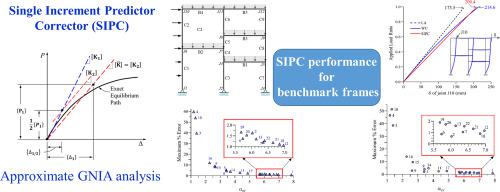Journal of Constructional Steel Research ( IF 4.0 ) Pub Date : 2021-08-27 , DOI: 10.1016/j.jcsr.2021.106870 C.W. Ziemian 1 , R.D. Ziemian 2

|
Most structural design codes require the consideration of geometric nonlinearities or second-order effects. Analysis of second-order forces and moments in structural members requires the solution of a nonlinear system of equilibrium equations. There are many ways to solve such a system, with varying levels of accuracy and computational expense. Numerical solution schemes for the geometric nonlinear analysis of structures have been shown to produce extremely accurate results when applying small load increments and/or implementing multiple linear analyses or iterations per increment. This paper proposes the use of an approximate solution scheme that utilizes two linear analyses within a single load increment, thereby simplifying the second-order elastic analysis to a predictor-corrector type algorithm with improved computational speed. Further contributing to its efficiency is the ability to use the analysis results from within the serviceability design process in the predictor step, thereby requiring only one linear corrector analysis per load combination investigated. The predictor-corrector scheme is proposed as a substitute for either an exact geometric nonlinear elastic analysis or the approximation of second-order results by amplifying first-order results. Twenty-two steel benchmark frames are used to assess the method's accuracy in comparison with a more exact solution scheme. Comparisons are also made, where possible, with interstory drift amplifiers applied to first-order results. The findings demonstrate the method's ability to maintain sufficient accuracy while significantly improving computational efficiency. Use of the method is demonstrated with two illustrative examples, and advantages and limitations are discussed, as well as insights regarding frame sensitivity to second-order effects.
中文翻译:

用于钢结构设计的高效几何非线性弹性分析:基准研究
大多数结构设计规范需要考虑几何非线性或二阶效应。分析结构构件中的二阶力和力矩需要求解非线性平衡方程组。有很多方法可以解决这样的系统,但精度和计算成本各不相同。结构几何非线性分析的数值求解方案已被证明在应用小载荷增量和/或执行多个线性分析或每个增量迭代时产生极其准确的结果。本文提出使用近似求解方案,该方案在单个载荷增量内利用两个线性分析,从而将二阶弹性分析简化为具有改进计算速度的预测器-校正器类型算法。进一步提高其效率的是能够在预测器步骤中使用适用性设计过程中的分析结果,因此每个负载组合只需要一个线性校正器分析。预测器-校正器方案被提议作为精确几何非线性弹性分析或通过放大一阶结果来近似二阶结果的替代方案。与更精确的求解方案相比,使用 22 个钢基准框架来评估该方法的准确性。在可能的情况下,还对应用于一阶结果的层间漂移放大器进行了比较。研究结果表明该方法能够保持足够的准确性,同时显着提高计算效率。











































 京公网安备 11010802027423号
京公网安备 11010802027423号